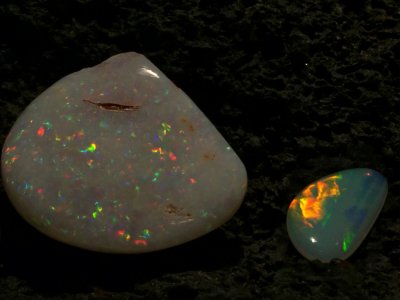mellowyellow
Well-known Member
Photographer: Mila Zinkova

Seen above are two opalised fossil shells found in Coober Pedy, Australia. The name Coober Pedy comes from the Aboriginal words kupa pity and means "white man in a hole" because the opals are collected in mines. These opals were first discovered in 1915 by accident when a teenage boy found a few rocks while his father and he were looking for gold.
Though the exact cause of opal formation is still disputed, many believe that silica was carried down into rock crevices by heavy rains. Once the water evaporated, what was left was a silica gel that then hardened over the course of what some believe is millions of years. This didn't happen overnight! It takes roughly 5 million years to solidify just one centimeter of opal. This theory makes sense considering opal has water in it. The water content of an opal can be upwards of 20 percent but is usually in the 5 percent range.

Seen above are two opalised fossil shells found in Coober Pedy, Australia. The name Coober Pedy comes from the Aboriginal words kupa pity and means "white man in a hole" because the opals are collected in mines. These opals were first discovered in 1915 by accident when a teenage boy found a few rocks while his father and he were looking for gold.
Though the exact cause of opal formation is still disputed, many believe that silica was carried down into rock crevices by heavy rains. Once the water evaporated, what was left was a silica gel that then hardened over the course of what some believe is millions of years. This didn't happen overnight! It takes roughly 5 million years to solidify just one centimeter of opal. This theory makes sense considering opal has water in it. The water content of an opal can be upwards of 20 percent but is usually in the 5 percent range.

